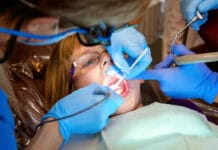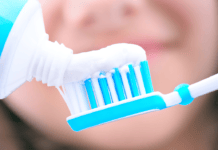Evidence indicates that toothbrushing abrasion is primarily a function of the abrasive level of the toothpaste. Essentially, the degree of abrasiveness of a given compound depends on its hardness, shape, size, and concentration.
Though pressure, frequency, duration of brushing, and toothbrush characteristics play a role in abrasion, toothpaste composition plays a larger role overall. A study published in JADA in 2017 states, "Evidence indicates that toothbrushing abrasion is primarily a function of the abrasive level of the toothpaste. Essentially, the degree of abrasiveness of a given compound depends on its hardness, shape, size, and concentration." Though toothbrush stiffness affects abrasion, the combination of stiffness and toothpaste abrasiveness is an important factor in hard tissue loss.
Hara, A.T., Turssi, C.P. Baking soda as an abrasive in toothpastes: Mechanism of action and safety and effectiveness considerations. J Am Dent Assoc. 2017 Nov; 148(11S): S27-S33. doi: 10.1016/j.adaj.2017.09.007. PMID: 29056187. Retrieved from https://pubmed.ncbi.nlm.nih.gov/29056187/
Unlike calcium carbonate, baking soda is naturally compatible with sodium fluoride.
The combination of sodium fluoride with calcium-containing abrasives in toothpaste resulted in a 60-90% loss of fluoride after one-week storage at room temperature. Toothpaste with baking soda as an abrasive showed a loss of 20-25% of fluoride after nine months of storage. Calcium absorbs the fluoride resulting in less to be taken up by the tooth structure.
Hattab, F.N. The state of fluorides in toothpastes. J Dent. 1989 Apr; 17(2): 47-54. doi: 10.1016/0300-5712(89)90129-2. PMID: 2732364. Retrieved from https://pubmed.ncbi.nlm.nih.gov/2732364/
Myneni, S.R. Effect of baking soda in dentifrices on plaque removal. J Am Dent Assoc. 2017 Nov; 148(11S): S4-S9. doi: 10.1016/j.adaj.2017.09.004. PMID: 29056188. https://jada.ada.org/article/S0002-8177(17)30809-7/pdf
Toothpastes with a higher percentage of baking soda, tend to have a lower RDA.
Toothpaste with a higher percentage of baking soda has a lower RDA; this includes all toothpastes manufactured by Arm & Hammer. When compared to other toothpastes that have baking soda, Arm & Hammer has a higher percentage of baking soda and a significantly lower RDA. Arm & Hammer toothpastes have 20-65% baking soda in their formulation, while other top brand toothpastes provide approximately 5-10%.
Hara, A.T., Turssi, C.P. Baking soda as an abrasive in toothpastes: Mechanism of action and safety and effectiveness considerations. J Am Dent Assoc. 2017 Nov; 148(11S): S27-S33. doi: 10.1016/j.adaj.2017.09.007. PMID: 29056187. Retrieved from https://pubmed.ncbi.nlm.nih.gov/29056187/
Studies show that fluoride alone raises the plaque pH to 6.8. When fluoride and baking soda are combined, what can the plaque pH level be elevated to?
“…an in-situ study analyzing the enamel changes during the daily episodes of demineralization that occurs with consumption of various foods showed that there is a reduction in mineral loss from the enamel from using baking soda dentifrice. A combination of baking soda with 1,100 parts per million fluoride rinse was able to elevate the final plaque pH to 8.3 compared with elevating to a pH of 6.8 with fluoride alone. Baking soda has a direct effect in elevating the bicarbonate levels in streptococcal plaque, which allowed it to retain a pH above the critical level during a sucrose insult. It is well established that baking soda offers additional protection against demineralization and caries by attenuation of the oral pH.”
In summary, a combination of baking soda and fluoride in toothpaste raises the pH level to 8.3, whereas a toothpaste with fluoride alone only raises the pH to 6.8. This indicates baking soda and fluoride combined provide better protection against acid attacks and may be a great option for patients with high caries rates due to lower pH levels.
Myneni, S.R. Effect of baking soda in dentifrices on plaque removal. J Am Dent Assoc. 2017 Nov; 148(11S): S4-S9. doi: 10.1016/j.adaj.2017.09.004. PMID: 29056188. retrieved from https://jada.ada.org/article/S0002-8177(17)30809-7/pdf
Though baking soda toothpaste has been shown to reduce pH levels and decrease S. mutans, it has no effect on gingival inflammation and bleeding.
In multiple studies, gingival inflammation and gingival bleeding were significantly reduced in patients using baking soda toothpaste when compared to a placebo. The reduction in gingival inflammation ranged between 8% and 34%, while the improvement in gingival bleeding sites ranged from 44.2% and 48%.
Myneni, S.R. Effect of baking soda in dentifrices on plaque removal. J Am Dent Assoc. 2017 Nov; 148(11S): S4-S9. doi: 10.1016/j.adaj.2017.09.004. PMID: 29056188. https://jada.ada.org/article/S0002-8177(17)30809-7/pdf
Toothpaste containing baking soda is more effective in stain removal and whitening than some non-baking soda-containing toothpastes with a higher abrasivity. The ability of toothpaste for tooth whitening is enhanced by increasing the content of baking soda.
Multiple studies have found a correlation between the amount of baking soda in toothpaste and the efficacy for stain removal and whitening. Increasing the content of baking soda from 45% to 65% enhanced the toothpaste's ability to whiten teeth. Further studies comparing the efficacy of baking soda-containing toothpastes to silica-containing toothpastes found the baking soda-containing toothpaste was more effective in reducing stain while being less abrasive.
Li, Y. Stain removal and whitening by baking soda dentifrice: A review of literature. J Am Dent Assoc. 2017 Nov; 148(11S): S20-S26. doi: 10.1016/j.adaj.2017.09.006. PMID: 29056186. Retrieved from https://pubmed.ncbi.nlm.nih.gov/29056186/
The relative dentin abrasivity score of pure baking soda is:
The RDA of pure baking soda is 7. Toothpastes that use baking soda as an abrasive generally have lower RDA scores than those that do not contain baking soda. Baking soda toothpaste may be a great option for patients that have generalized recession and root exposure as it is less likely to damage exposed dentin.
Hara, A.T., Turssi, C.P. Baking soda as an abrasive in toothpastes: Mechanism of action and safety and effectiveness considerations. J Am Dent Assoc. 2017 Nov; 148(11S): S27-S33. doi: 10.1016/j.adaj.2017.09.007. PMID: 29056187. Retrieved from https://pubmed.ncbi.nlm.nih.gov/29056187/








